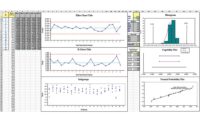From the Editor
Harry Potter & the Engineering Design Process
Solving Voldemort-Sized Problems in Test and Measurement.

The engineering design process—based closely on the scientific method—is “the set of steps that a designer takes to go from first, identifying a problem or need to, at the end, creating and developing a solution that solves the problem or meets the need.”
The steps of the engineering design process are to:
- Define the Problem
- Do Background Research
- Specify Requirements
- Brainstorm Solutions
- Choose the Best Solution
- Do Development Work
- Build a Prototype
- Test and Redesign
As pointed out in this month’s Measurement article, defining the problem can start on the “back of a napkin.” It worked for J.K. Rowling (although it is a myth it is one that is so appealing it persists and is one I am willing to perpetuate for the sake of this column). The renowned children’s writer started her writing process by jotting down endless notes on the back of napkin’s and finished with one of the most popular series of novels of all time, Harry Potter (not to mention some of the highest grossing movies of all-time based on those novels).
For the custom CMM styli developer, “back of the napkin” usually refers to a fax or email with a freehand diagram of a proposed stylus and a crude sketch of the part it’s supposed to measure, hastily prepared by a CMM operator that is in a hurry to get the right probe and styli to do the job.
You can follow the correlations between styli development and the engineering design process—featuring intriguing analogies to pizza and lollipops—in Mark Osterstock’s article, “Custom CMM Styli.”
Applying the process to a process, this month’s Software article touches on the last point of the engineering design process—Test and Redesign—testing the efficiency of the long-standing gage repeatability and reproducibility (R&R) process.
Take 10 parts and have three operators measure each two times. It’s the essence of the standard approach to Gage R&R.
But our authors ask the questions: How accurate of an assessment can you expect using just 10 parts? What about using four operators? Why not three times?
They performed studies to find out, first simulating 1,000 studies using 30 parts, and then 100 parts, with three operators measuring each part two times. Next, they performed these studies using four operators and, lastly, with three replicates instead of two, varying the number of parts and operators as they conducted different iterations on the standard to build comparisons of effectiveness, skewness and variation.
What did they find? The authors write, “While it might not be perfect, the standard Gage R&R approach is a powerful tool for measurement system analysis.”
For the full story and the results of their experiments, read “How Does Standard Gage R&R Measure Up?” by Joel Smith and Eston Martz in
this month’s Quality.
Enjoy and thanks for reading!
Looking for a reprint of this article?
From high-res PDFs to custom plaques, order your copy today!





